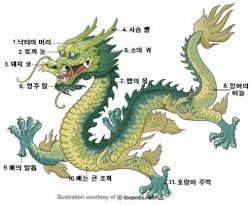Difference between revisions of "Long 龍 ''dragons''"
m (1 revision: Adminos 18 sept 02.04AM) |
|||
| Line 1: | Line 1: | ||
[[File:12jan dragon.jpg|thumb|250px|]] | [[File:12jan dragon.jpg|thumb|250px|]] | ||
| − | The [[dragon]] (long 龍) is an [[auspicious]] [[animal]] in {{Wiki|Chinese}} [[mythology]]. It is, although in appearance similar to the {{Wiki|occidental}} [[dragon]], a good [[animal]] and not a [[Symbol]] of [[evils]]. The [[dragon]] is a scaly [[animal]] that can have different colours or sizes. In spring it ascends to [[Heaven]] and hides itself in deep wells in autumn. [[Sages]], [[mythological]] rulers or immortals are often said to ride on a [[dragon]] in their travels through the sky. It was also possible to breed [[Dragons]], like [[Master]] Dong 董, a servant of [[Wikipedia:Shun (Chinese leader)|Emperor Shun]] 舜 who fed a lot of [[Dragons]]. He was therefore given the family [[name]] of Huanlong 豢龍. It is also said in the Song period 宋 (960-1279) [[book]] Nanbu xinshu 南部新書 that [[Dragons]] feared {{Wiki|candles}} and loved jade, and that they liked to eat the meat of swallows. The [[book]] Guangya 廣雅 says that [[Dragons]] with scales were called jiaolong 蛟龍, [[Dragons]] with wings yinglong 應龍, [[Dragons]] with horns qiulong 虬龍, and such without horn chilong 螭龍. | + | The [[dragon]] (long 龍) is an [[auspicious]] [[animal]] in {{Wiki|Chinese}} [[mythology]]. It is, although in [[appearance]] similar to the {{Wiki|occidental}} [[dragon]], a good [[animal]] and not a [[Symbol]] of [[evils]]. The [[dragon]] is a scaly [[animal]] that can have different colours or sizes. In spring it ascends to [[Heaven]] and hides itself in deep wells in autumn. [[Sages]], [[mythological]] rulers or immortals are often said to ride on a [[dragon]] in their travels through the sky. It was also possible to breed [[Dragons]], like [[Master]] Dong 董, a servant of [[Wikipedia:Shun (Chinese leader)|Emperor Shun]] 舜 who fed a lot of [[Dragons]]. He was therefore given the family [[name]] of Huanlong 豢龍. It is also said in the [[Wikipedia:Song Dynasty|Song period]] 宋 (960-1279) [[book]] Nanbu xinshu 南部新書 that [[Dragons]] feared {{Wiki|candles}} and loved jade, and that they liked to eat the meat of swallows. The [[book]] Guangya 廣雅 says that [[Dragons]] with scales were called jiaolong 蛟龍, [[Dragons]] with wings yinglong 應龍, [[Dragons]] with horns qiulong 虬龍, and such without horn chilong 螭龍. |
The {{Wiki|green dragon}} qinglong 青龍 or canglong 蒼龍 is the [[Symbol]] of the {{Wiki|east}}, spring and lush vegetation. | The {{Wiki|green dragon}} qinglong 青龍 or canglong 蒼龍 is the [[Symbol]] of the {{Wiki|east}}, spring and lush vegetation. | ||
| Line 7: | Line 7: | ||
'''Source''': | '''Source''': | ||
| − | :Yuan Ke 袁珂 (ed. 1985). Zhongguo shenhua chuanshuo cidian 中國神話傳說詞典, pp. 117, 184. Shanghai: Shanghai cishu chubanshe. | + | :Yuan [[Ke]] 袁珂 (ed. 1985). Zhongguo shenhua chuanshuo cidian 中國神話傳說詞典, pp. 117, 184. {{Wiki|Shanghai}}: {{Wiki|Shanghai}} cishu chubanshe. |
{{R}} | {{R}} | ||
Revision as of 16:44, 7 December 2013
The dragon (long 龍) is an auspicious animal in Chinese mythology. It is, although in appearance similar to the occidental dragon, a good animal and not a Symbol of evils. The dragon is a scaly animal that can have different colours or sizes. In spring it ascends to Heaven and hides itself in deep wells in autumn. Sages, mythological rulers or immortals are often said to ride on a dragon in their travels through the sky. It was also possible to breed Dragons, like Master Dong 董, a servant of Emperor Shun 舜 who fed a lot of Dragons. He was therefore given the family name of Huanlong 豢龍. It is also said in the Song period 宋 (960-1279) book Nanbu xinshu 南部新書 that Dragons feared candles and loved jade, and that they liked to eat the meat of swallows. The book Guangya 廣雅 says that Dragons with scales were called jiaolong 蛟龍, Dragons with wings yinglong 應龍, Dragons with horns qiulong 虬龍, and such without horn chilong 螭龍.
The green dragon qinglong 青龍 or canglong 蒼龍 is the Symbol of the east, spring and lush vegetation.
Other auspicious Animals are phoenix (fenghuang 鳳凰), turtle (gui 龜) and Unicorn (qilin 麒麟).
Source:
- Yuan Ke 袁珂 (ed. 1985). Zhongguo shenhua chuanshuo cidian 中國神話傳說詞典, pp. 117, 184. Shanghai: Shanghai cishu chubanshe.
